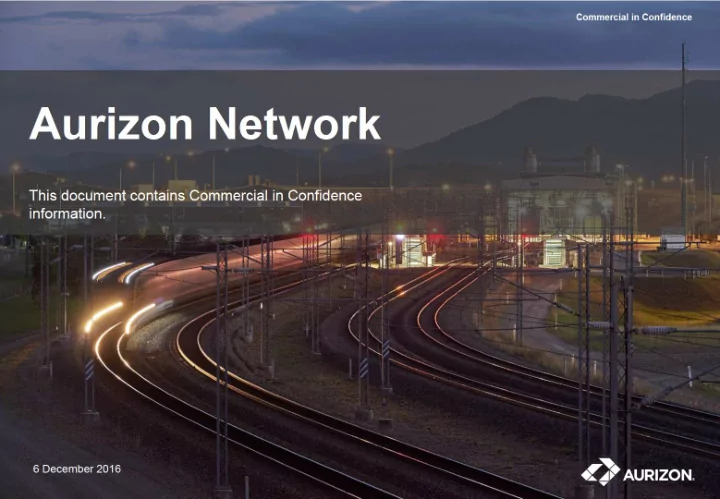

Commercial in Confidence Consistent with the QCA Act we are seeking “a return on investment commensurate with the regulatory and commercial risks involved” • Relatively small number of customers, exposed to a single asset class (coal) • Volatile operating environment, including increased counterparty risk and longer term structural issues with regard to future demand of thermal coal NOT A REGULATED • Fragmentation of the Regulated Asset Base (RAB) by system increasing the risk of asset UTILITY stranding • Revenue deferrals which result in expansion capital being excluded from the RAB e.g. approximately $260m of Wiggins Island Rail Project (WIRP) related capex FFO/Debt Aurizon Utilities Ratio Network • Aurizon Network is perceived by the rating agencies as REAL WORLD having a higher business risk and thus requires a higher Moody’s >18% >7%-8% EMPIRICAL credit metrics (e.g., FFO/Debt) to maintain the same EVIDENCE BBB+ credit rating S&P >13% >7%-8% 2
Commercial in Confidence We believe that a different approach by the QCA on 3 of the WACC parameters will drive a return closer to Aurizon Network’s risk profile Regulator MRP Risk free rate Distribution MRP Rate • Siegel approach is one of the four methods used by the QCA to determine Siegel Term Long FAB data the MRP matching term • Siegel approach disregarded by all other Australian regulators and most QCA x x international regulators NZCC n/a x AER x x Risk free rate • The QCA aligns risk- free rate term with Aurizon Network’s regulatory cycle ACCC x x (4-year) to satisfy the theoretical NPV=0 principle • Risk free rate aligned to the regulatory term is unique to the QCA and IPART x x NZCC • ERA* x x The QCA is the only regulator that uses different risk-free rate terms in the CAPM model ESCSA x x ESC x x Distribution rate • As acknowledged by the Tribunal, estimating distribution rate using FAB UK Regulators (e.g., x x n/a data is not contentious among regulators Ofgem) • The QCA is an outlier among regulators to use the ASX 20 firm approach US Regulators (e.g., x x n/a which inflates distribution rate due to the existence of foreign tax STB) * The ERA does not use term matching for rail but does for energy 4
Commercial in Confidence Aurizon Network’s WACC Proposal Aurizon Network Key Points UT4 FD UT5 Proposal Averaging Period 20 ‐ day to 31 Placeholder N/A Oct 2013 Term of Risk ‐ free Rate • Consistent with both domestic and international regulators 4 ‐ year 10 ‐ year • Consistent with commercial valuation experts expectations • Unrealistic assumption of asset value certainty at the end of regulatory period Risk ‐ free Rate • Except term, consistent with UT4 approach based upon 20 day averaging period of 3.21% 2.13% Commonwealth government securities MRP • MRP weights applied by QCA remain unclear • The QCA has consistently applied the same MRP. AN assumes that there is negligible weight applied to those approaches that are sensitive to market 6.5% 7.0% movements. • Understates the return on equity and implies a 1 for 1 relationship with the risk free rate Asset Beta 0.45 0.55 • Comparator companies has been expanded to include international entities with similar characteristics and are regulated. Equity Beta • Revenue protection mechanism only cover for the regulatory period, not the economic life of the asset 0.8 1.0 • Does not address risks such as RAB fragmentation (system and traction choice), volume risk through QCA revenue deferrals Gearing 55% 55% • No change Cost of Equity • The return demanded by the market is materially higher than the market return calculated through the mechanistic application of the QCA’s CAPM Model • The QCA CAPM model has underestimated the market return by 120bps 8.41% 9.13% • Over the past 4 years (2012-2015) the differential has grown and averaged 173bps, primarily driven by the decline in the RFR to a historical low and lack of material offset from the MRP Credit Rating • Credit ratings agency’s have reviewed credit ratings with a view to downgrade coal BBB+ BBB+ export related infrastructure. Rating agencies link the riskiness of the business to the industry and its customers. Footer text 6
Commercial in Confidence Aurizon Network’s WACC Proposal Aurizon Network Key Points UT4 FD UT5 Proposal Total Debt Margin • Inclusion of the pooled regression model in line with DBCT decision • Inclusion of foreign bonds issued by Australian entities which is consistent with 2.94% 2.732% Aurizon Network commercial approach • Inclusion of currency and interest rate swap costs Cost of Debt • A BBB+/Baa1 credit rating is required by the business to efficiently and effectively obtain debt financing in the domestic and International Market • Debt Financiers are attuned to the Coal Industry exposure 6.15% 4.86% • Size, tenure and diversification necessitates Aurizon Network sourcing from international markets, therefore the debt allowance should provide compensation for these attributes. Gamma • Maintained a consistent approach by using the ATO Data (Franking Account Balance). 0.47 0.25 • Address the issues associated with Lally’s approach which includes consideration to firms with foreign income • Alignment to market conditions and not a theoretical model. Post ‐ tax Nominal WACC 7.17% 6.78% Footer text 7
Recommend
More recommend